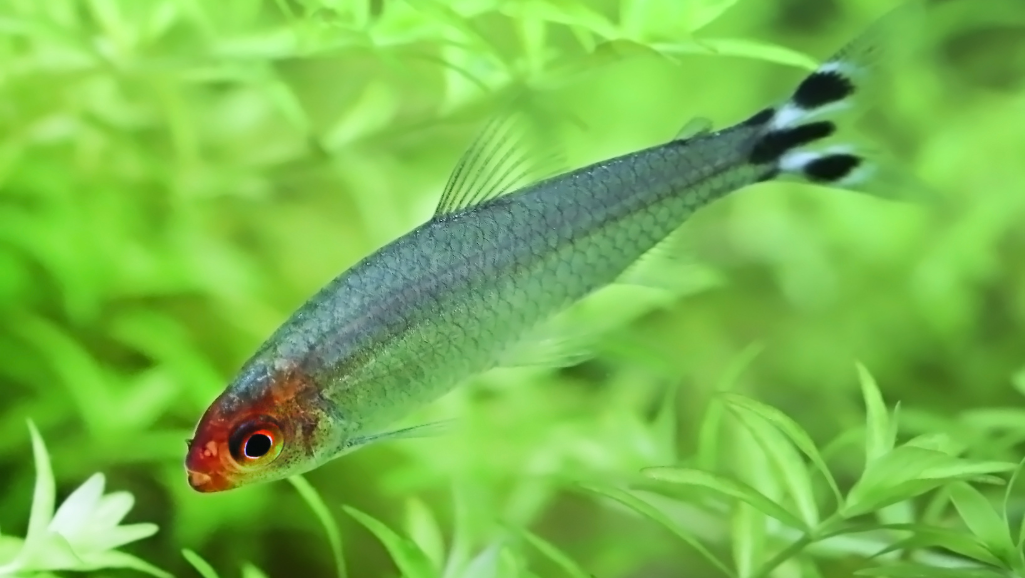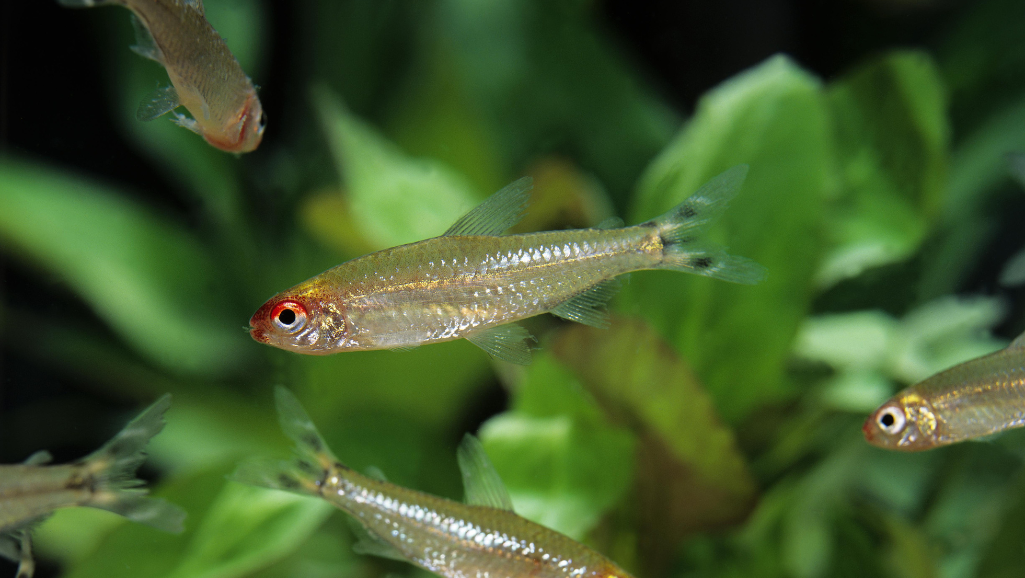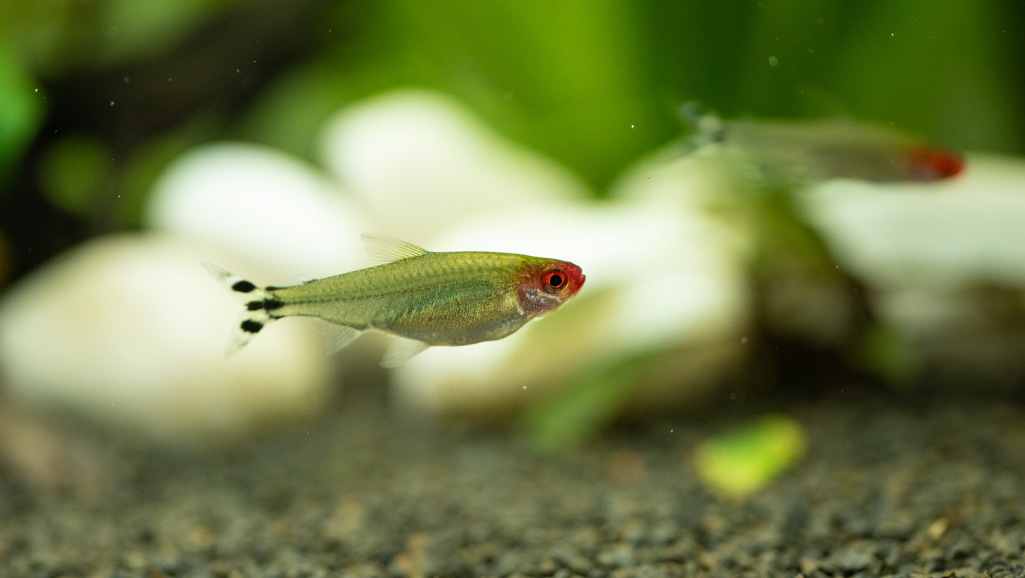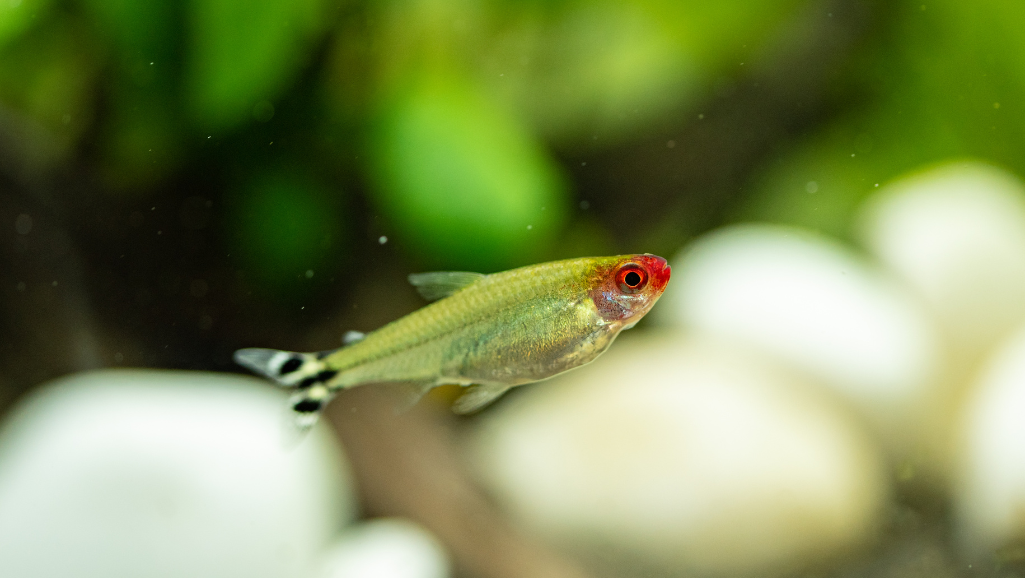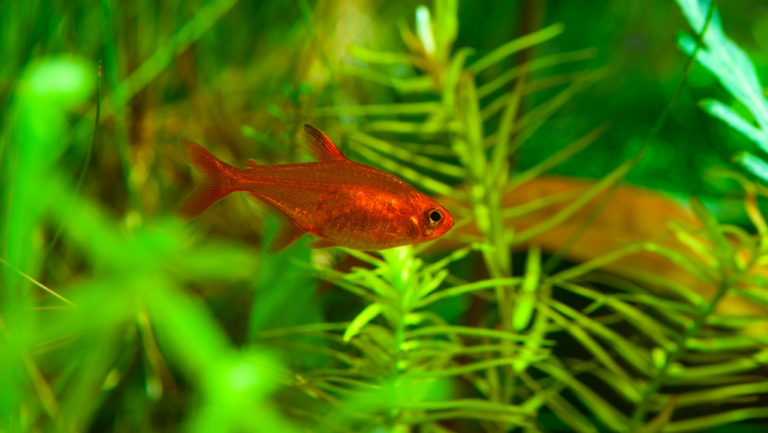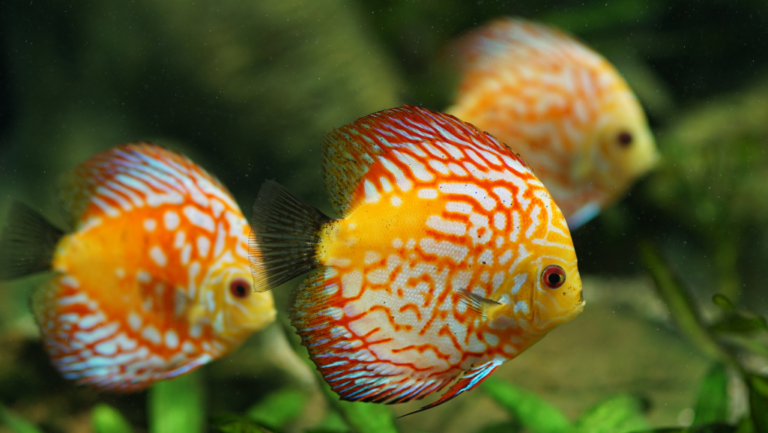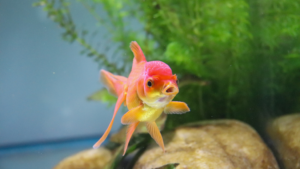People love having Rummy Nose Tetras in their aquariums. They are known for their bright colors and lively presence. These small fish have a red head and a silver body, making them stand out.
They are a favorite among both new and experienced aquarium owners. They can make any Rummy Nose Tetra aquarium look better.
Proper care is key to keeping Rummy Nose Tetras healthy. They need a clean and well-maintained tank. A 20-gallon tank is a good size for them.
They like to swim in groups, so having at least eight of them is best. Keeping the water temperature and pH levels right is also important. This helps them thrive.
Key Takeaways
- 20-gallon minimum tank size for proper schooling and swimming.
- Keep in groups of 8 or more to appreciate their social swimming dynamics.
- Ideal water temperature between 74–84°F for optimum health.
- pH levels of 5.5–7.5, soft to moderately hard GH for familiar water conditions.
- Diligent water quality management with weekly conditioning.
- Fish compatibility with non-aggressive species such as corydoras & other tetras.
- Conscious nutrition with a balanced omnivorous diet.
Discover the Rummy Nose Tetra: A Pristine Addition to Aquatic Life
Welcome to the world of the Rummy Nose Tetra. These fish add vibrant life and color to any freshwater aquarium. They are known for their bright red noses and shimmering bodies. Understanding their needs means knowing their physical traits and keeping the water just right for them.
Identifying Your Rummy Nose Tetra: Petitella Species Explained
Identifying Rummy Nose Tetras can be fun because of their similar looks in the petitella genus. They have a bright red nose and a sleek body. You can tell them apart by looking at their stripe patterns and body length.
Their bright red color shows they are healthy. They have angular fins and a body that looks almost transparent. In a well-lit tank, they stand out against dark substrates and greenery.
Understanding the Vital Parameters: Tank Size, Water Conditions, and Group Dynamics
- Minimum Tank Size: For their best health, a 20-gallon tank is needed. This size lets them swim and live in groups.
- Water Parameters: They need a temperature of 75-80°F and a pH of 5.5 to 7.0. Keeping these conditions right keeps them healthy and active.
- Social Structure: They should be kept in groups of at least six. But, eight to ten is best for their natural behavior and less stress.
Rummy Nose Tetras are beautiful and peaceful. They are great for community tanks. They do well with other calm fish. Keeping the water clean, feeding them right, and keeping the temperature stable helps them thrive.
In conclusion, the Rummy Nose Tetra is truly captivating. With the right care and water conditions, they will add color and life to your tank. Nurturing these fish is rewarding and can turn your tank into a lively, river-like ecosystem.
Creating the Ideal Habitat for Rummy Nose Tetras
Creating a home for your Rummy Nose Tetras that feels like their natural habitat is key. These tetras come from the Amazon’s blackwater areas. They do best when their home is similar to their natural one.
To set up your aquarium, focus on the blackwater elements they love. Use dark water with tannins to match their soft, acidic home.
- Substrate: Choose dark, fine substrate to match their riverbeds.
- Vegetation: Add plants like Anubias and Java Fern for shelter and to mimic their habitat.
- Driftwood and Leaves: Driftwood and leaves add tannins, softening the water and lowering pH, perfect for your tetras.
Temperature and water chemistry are also important. They like warmer water, between 72°F to 80°F. They do well in softer, acidic water with pH levels from 6.0 to 7.0. Keeping these conditions stable helps them stay healthy and colorful.
Rummy Nose Tetras are best in groups of 8-12. This encourages social behavior and reduces stress. It also makes their synchronized swimming more impressive.
“Creating a slice of the Amazon in your aquarium not only provides a sanctuary for your Rummy Nose Tetras but also brings a piece of exotic nature into your living space.”
In conclusion, making your aquarium like their blackwater home is crucial. It sets the stage for a thriving Rummy Nose Tetra habitat. Dive into this project to see the beauty and complexity of these fish.
The Importance of Water Quality for Rummy Nose Tetra Well-Being
Keeping the water quality right is key for Rummy Nose Tetras. They are very sensitive to changes in their environment. So, Rummy Nose Tetra water quality is a big part of taking care of an aquarium.
Mimicking the Blackwater Environment: Tannins and pH Levels
To make a home for Rummy Nose Tetras, we need to create a blackwater environment. This means soft, acidic water with lots of tannins. We can do this by using certain substrates and adding driftwood and leaves. These items help lower the pH to 5.5 to 7.0, which is perfect for them.
This setup is not just good for their health. It also makes their colors pop, making them a highlight in your tank.
Spotting Signs of Distress: What Pale Coloration Means
It’s important to watch for signs of trouble in your tetras. A pale nose is a big warning sign. It means the water might not be right. You should test the water and make changes fast to keep your tetras healthy.
Regular care, like aquarium cycling, is also key. Cycling sets up a system that keeps the water safe. It turns bad stuff into something safer. This is important for keeping your tetras safe from harm.
In short, paying close attention to the water quality is crucial. With the right care and attention, Rummy Nose Tetras can live happily and healthily in your tank. By mimicking their natural home and watching for signs of trouble, you can enjoy their beauty and activity.
Diet and Nutrition: Feeding Your Rummy Nose Tetra the Right Way
It’s key to give your Rummy Nose Tetra the right diet for their health and long life. Since they are omnivorous fish, knowing their food needs and tetra feeding habits is important. In the wild, they eat both plants and small animals, changing with the seasons. It’s important to feed them a similar mix at home to keep them healthy.
Balanced Diet: From Omnivorous Tendencies to Favorite Foods
Rummy Nose Tetras need a diet that meets their omnivorous fish care needs. They should eat both meat and plants. In captivity, their diet should be similar to their natural one, with a mix of:
- High-quality flake foods for tropical fish
- Frozen or live foods like brine shrimp, daphnia, and bloodworms
- Algae and plant detritus during certain seasons
This varied diet keeps them healthy and active in their home.
Variety in Feeding: Incorporating Live and Plant-Based Options
It’s important to vary your Rummy Nose Tetra’s food. A mix of foods ensures they get all the nutrients they need. Feeding them like they do in their Amazonian home helps them stay healthy. Following recommended feeding practices helps too. Feed them small amounts twice a day, so they eat everything in a few minutes. This keeps their water clean and prevents overfeeding.
Following these feeding tips helps your Rummy Nose Tetra stay healthy and colorful. They will be a joy to watch in your aquarium.
Social Behaviors and Tank Mate Compatibility
Rummy Nose Tetras are perfect examples of schooling fish. They do best in groups, which makes them feel safe and happy in community aquariums. They love to swim together, creating a beautiful sight in a well-kept tank. It’s important to choose the right Rummy Nose Tetra tank mates for a peaceful tank.
- Corydoras Catfish: These fish are calm and stay at the bottom, making great friends for Rummy Nose Tetras.
- Small Characins: Like Neon Tetras, they need similar water and like the same environment.
- Kuhli Loaches: They are quiet and add beauty to the tank without bothering the Rummy Nose Tetras.
Creating a tank for these fish should look like the Amazon’s Blackwater. It should have lots of shade and soft, acidic water. Using fine sand and driftwood helps make it feel like home for them.
Rummy Nose Tetras get along well with other peaceful fish. But, they need the right water to be happy. This means keeping the water between 76-80°F and a pH of 6.5 to 7.0. For more tips, check out guides on Neon Tetra care.
To keep Rummy Nose Tetras happy in community aquariums, you need to understand them. Care for them well and pick the right tank mates. This way, your aquarium will be a lively and peaceful place for these lovely schooling fish.
The Delicate Process of Rummy Nose Tetra Breeding
Breeding Rummy Nose Tetras is a unique challenge. They have specific needs and require gentle care. Knowing their breeding habits can help increase success and protect this species.
From Conditioning to Spawning: The Breeding Journey
Successful Rummy Nose Tetra breeding begins with the right tank setup. It should mimic their natural habitat, like the flood season. The water should be soft, acidic, and around 84°F to match their South American home.
Adding fine-leaved plants and soft lighting helps too. This encourages them to breed.
Rummy Nose Tetras scatter their eggs among plants. It’s important to have plants where the eggs can stick without being harmed.
Post-Spawn Care: Ensuring the Survival of Fry
After spawning, caring for the fry is key. The first days are very important. Start with infusoria, then move to micro worms and baby brine shrimp as they grow.
Keeping the water clean is crucial. Make sure there’s no ammonia or nitrites. Regular, gentle water changes are also important.
Keeping the breeding tank quiet and still helps the fry. Watching them closely and slowly introducing them to the main tank can help them survive.
With careful attention, raising Rummy Nose Tetras from eggs to adults can be rewarding. For more tips on caring for your fish, visit our aquarium life.
Rummy Nose Tetra Lifespan and Growth: From Fledgling to Full Fledged
Understanding the Rummy Nose Tetra lifespan is key for fish keepers. These colorful fish can live in your tank for many years. They add beauty and life to your underwater world.
Watching them grow from tiny fry to adult is amazing. Knowing how they grow helps keep your tank beautiful and your fish healthy.
The Lifespan Timeline: What to Expect
Rummy Nose Tetras start small but grow fast. With the right care, they quickly grow. They reach full size in a few months.
As they grow, their red snout gets more vibrant. This shows they are healthy. Watching their color and activity helps you know they’re doing well.
Growing Healthy Tetras: Monitoring Growth and Health
Watching your Rummy Nose Tetras grow is important. It’s not just about their size. It’s about their behavior, diet, and how they interact with others. Healthy tetras are colorful and active.
To keep them healthy, feed them well and keep the water clean. Don’t overcrowd the tank. Check the water often to avoid stress and sickness.
In summary, the Rummy Nose Tetra lifespan can be long and healthy with proper care. This care makes your tank a vibrant and thriving place.
Conclusion
Adding Rummy Nose Tetras to your aquarium is a journey of learning about freshwater fish care. These tetras bring life and color to your tank. They need the right water temperature, pH, and tank size to thrive.
Good care for Rummy Nose Tetras includes the right food and social environment. They prefer certain water hardness and need the right tank mates. Research shows how important their behavior and schooling are.
Keeping Rummy Nose Tetras happy requires dedication and attention to detail. They need the right water quality and care to live up to 5 years. With patience and research, you can enjoy their lively behavior and create a vibrant aquarium.

